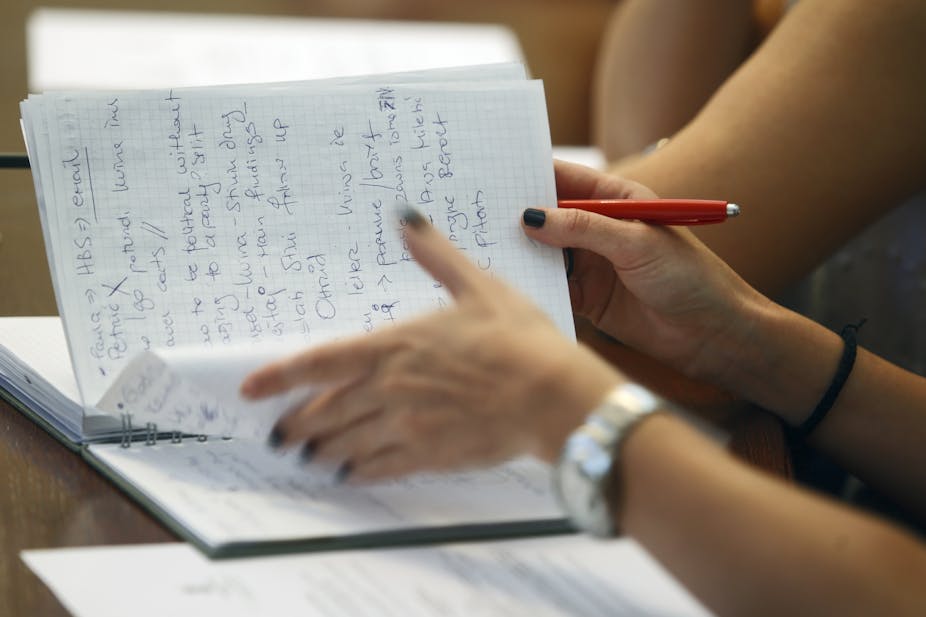If it feels like you forget new information almost as quickly as you hear it, even if you write it down, that’s because we tend to lose almost 40% of new information within the first 24 hours of first reading or hearing it. If we take notes effectively, however, we can retain and retrieve almost 100% of the information we receive.
Learning how to retain information
The most effective note-taking skills involve active rather than passive learning. Active learning places the responsibility for learning on the learner. Research has found that, for learning to be effective, students need to be doing things with the material they are engaging with (reading, writing, discussing, solving problems).
They must also be thinking about the thinking (metacognition) involved in engaging with the material. This means that, while students are learning the content, they should also be thinking about how they are learning it. What is causing confusion? How does your thinking change about this topic as you are learning? What has worked well for you in learning this topic that you should do next time? What hasn’t worked so well so you don’t make that learning mistake again?
Studies have found note taking is most effective when notes are organised and transformed in some way or when a teacher gives examples of good notes. An effective note-taking strategy requires effort. Half the battle with students is helping them understand the reasons for needing to take and interact regularly with their notes.
Students often tell teachers they have excellent memories and don’t need to take notes because they can easily recall information. Research says this is not the case.
The goal of effective note taking is to help recall what has been learned and retain that information over time. German psychologist Hermann Ebbinghaus in 1895 conducted some of the first experiments on memory and recall, and spaced learning. He developed the forgetting curve, which shows how information is lost quickly over time if there is no strategy or effort to retain it.

The rate of forgetting is minimised if students interact (re-read/discuss/write/engage) with their notes within 24 hours. A second repetition for a shorter period of time within a day brings recall back up to 100%. A third repetition within a week for an even shorter time brings recall back to 100%.
What are the most effective ways to take notes?
I teach the Cornell Note-Taking System, which was developed in the 1950s as part of a university preparation program (AVID). Effective note taking is interactive and involves using the original notes many times over to build memory of the content, rather than seeing note taking as just a one-off copying activity. The important features of this system are captured in the images below.


There are four stages to good note taking:
- Note taking
- Note making
- Note interacting
- Note reflecting
In note taking, students:
• Prepare a page to take notes the same way each time. An essential question at the top of the page focuses the learner on the key learning objective that they should be able to discuss upon leaving the class
• Rule the page into two columns, with the first column taking up about a third of the page. The space on the left is for questions and notes that may be added in later as students reflect on their notes. The space on the right is for the student to take notes from the lecture, textbook, laboratory experiment, video, audio, whatever the source
• Listen and take notes in their own words – paraphrase what they hear so it makes sense to them rather than write down verbatim what they hear/see
• Leave spaces and lines between main ideas for revising later and adding information
• Develop their own consistent system of abbreviations and symbols to save time as they take notes
• Write in phrases, not complete sentences
• Use bullet points and lists where possible
• Learn how to listen for important information versus trivial information
• Take cues from the lecturer or source, e.g. “This is important…”
• Use highlighters and colour to indicate key ideas, changes in concepts or links between information.
In note making, students:
• Review and revise the content of their notes
• Write questions in the left-hand side near where the answer is contained on the right-hand side
• Connect key chunks of material in the notes pages using colour or symbols
• Exchange ideas and collaborate with other students to check for understanding and test the comprehensiveness of each other’s notes.
In note interacting, students:
• Link all the learning together by writing a summary that addresses the essential question and answers the questions from the left margin. Note that a summary is different from a reflection that focuses on the student’s response to the learning task or content
• Learn from their notes by building in to their study timetable regular times for revising their notes for each subject
• Cover the information on the right-hand side and use the questions as study prompts before a test.
In note reflecting:
• Written feedback should be provided by a peer, tutor or teacher to check for the student’s understanding in the initial learning phase
• Students should address the feedback by focusing on one area of challenge they are experiencing in their learning
• Students should also reflect over an entire unit on a regular basis leading up to exams and tests.

